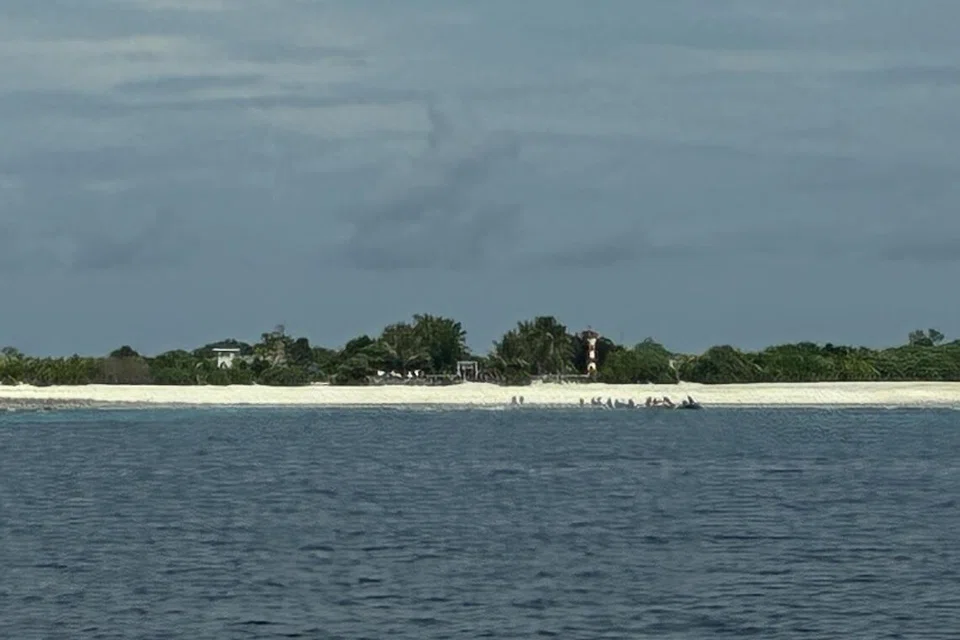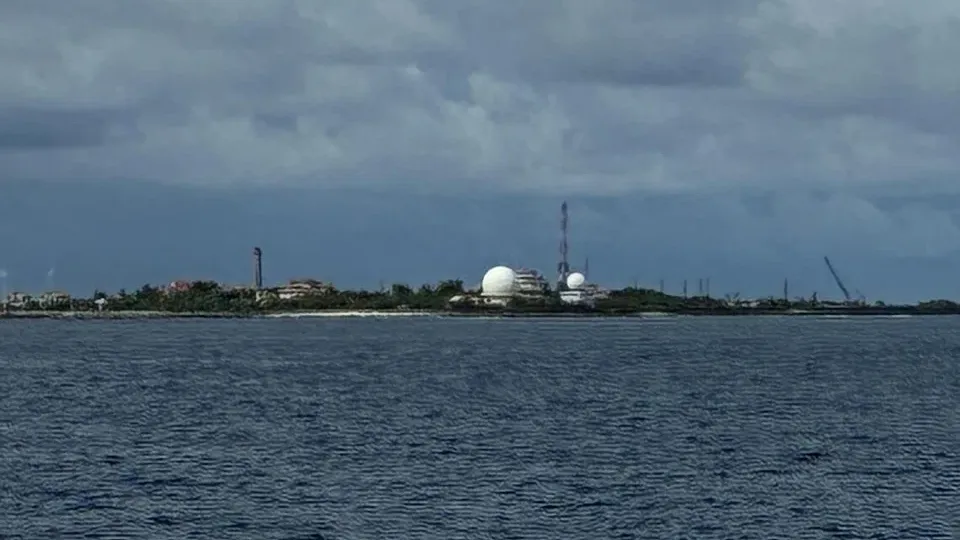October 30, 2025
SOUTH CHINA SEA – Vietnam is accelerating land reclamation efforts on a strategic reef located in the northern Spratly archipelago in the South China Sea, just a few kilometres from a Philippine-occupied island.
The hitherto little-discussed South Reef, known as Da Nam to the Vietnamese, was originally a low-tide elevation that is submerged at high tide, with two pillbox structures that served as military outposts.
Reclamation has proceeded rapidly over the past two years and the reef now covers a land area of more than 60ha, making it one of the largest Vietnam-occupied features in the Spratlys.
This reporter recently visited South Reef and witnessed the construction work extending across the white sands, with dozens of towering cranes cranking away non-stop.
Several Vietnamese fishing vessels were seen plying the surrounding waters.
Satellite imagery shows that Vietnam has sped up its land reclamation efforts in the Spratlys, expanding all 21 of its occupied features with artificial land and potentially surpassing China’s total reclaimed area.
Hanoi began reclamation work on South Reef in October 2023, some 35 years after it occupied the reef in the CQ-88 Campaign – a series of Vietnamese military operations between 1978 and 1988 to assert its sovereignty in the Spratly Islands.
Of that volume, 60 per cent of maritime trade passes through Asia, with the South China Sea carrying an estimated one-third of global shipping.
Now, “with the newly developed (reclaimed land in) South Reef, Hanoi has strengthened its control in this area (the Spratlys)”, noted Mr Tuan, who focuses on the South China Sea and border issues.
Recent satellite images of South Reef show ongoing construction, including new buildings, possibly military barracks and ammunition depots, along with other structures.
Local media reported that facilities such as a communal space and gym have been built on the reef for the soldiers stationed there, who are also encouraged to grow their own vegetables and rear chickens for eggs and fresh meat.
South Reef lies less than 5km from another Vietnam-occupied feature, Southwest Cay or Song Tu Tay to the Vietnamese; and about 8km from Northeast Cay or Parola Island to the Filipinos.
Both cays, or low-lying coral banks, in the Spratlys were under South Vietnam’s control until 1968, when the Philippines took possession of the nearly 13ha Parola Island.
The 12ha Southwest Cay boasts the highest point in the archipelago at 4m, where the Vietnamese installed a lighthouse in 1993, and other facilities including a common hall and military barracks.
In another development, a 3.2km runway is taking shape on Barque Canada Reef, Vietnam’s largest reclaimed outpost in the Spratlys, which has nearly doubled in size to 167ha currently.
When completed, it will be Hanoi’s second runway in the island chain, apart from the short airstrip on the 16ha Spratly Island which it also controls.
Any friction with the Philippines likely to be contained
The more developed Vietnam-occupied features stand in stark contrast to the Philippine-occupied island in the Spratlys archipelago.
Parola Island – which is located less than 3km north-east of Southwest Cay – remains pretty much undisturbed, with only a few coconut trees, a small lighthouse and low-rise buildings for the Philippine Navy garrison stationed there.
Troops from both sides are said to be amiable, and get together informally for sports activities like football or volleyball.

Parola Island remains pretty much undisturbed, with only a few coconut trees, a small lighthouse and low-rise buildings for the Philippine Navy garrison stationed there. PHOTO: THE STRAITS TIMES
Mr Justin Baquisal, a national security analyst at Philippine think-tank FACTS Asia, told ST: “Manila is not really alarmed by Hanoi’s island-building, which is primarily blunted by perceptions that Vietnam is not hostile to the Philippines.
“What there is more of (now) is a sense of ‘fear of missing out’, that other claimants in the South China Sea are building infrastructure and so the Philippines must do so as well… but it is unlikely to make any specific move in the near term.”
Vietnam analyst Vu Lam said that Vietnam’s reclamation efforts in the South China Sea “may cause some friction with the Philippines, but it is likely to be contained”.
“The two sides signed complementary coast guard and maritime cooperation agreements in 2024, establishing a hotline and an incident-prevention mechanism to manage encounters in disputed waters,” said the Asean affairs observer.
“Both governments frame these tools as practical guardrails to prevent misunderstanding while prioritising collective deterrence of Chinese coercion,” he added.
While not all of the Spratly Islands are disputed by various countries, the entire archipelago is a site of overlapping territorial claims from parties such as China, Vietnam, Malaysia, Brunei, Taiwan and the Philippines.
Vietnam has significantly expanded island-building work in areas it claims in the Spratly Islands chain and will match and likely surpass the scale of such activity there by China, a Washington think-tank reported in August.

Recent satellite imagery showed that since the start of 2025, Vietnam has expanded island-building to eight features previously untouched by a round of reclamation that began in 2021, according to the report from the Centre for Strategic and International Studies’ Asia Maritime Transparency Initiative (AMTI).
“All 21 Vietnamese-occupied rocks and low-tide elevations in the Spratly Islands have now been expanded to include artificial land,” when four years ago a majority hosted only isolated pillbox structures, it said.
“As of March 2025, Vietnam had created about 70 per cent as much artificial land in the Spratlys as China had,” it said.
“Reclamation at these eight new features all but ensures that Vietnam will match – and likely surpass – the scale of Beijing’s island-building.”
AMTI’s director Gregory Poling told ST: “We can’t say for sure when Vietnam will surpass the total amount of artificial landfill China created in the Spratly Islands, but I would expect some time in 2026.”
China silent but not ‘sitting idle’
Yet, the three largest artificial islands in the South China Sea – Mischief, Subi and Fiery Cross reefs – are Chinese-controlled and have been militarised with hangars, runways and missile systems.
China claims the largest portion of the Spratly Islands, based on its expansive “nine-dash line” claim over much of the South China Sea.
In 2016, in a case brought by the Philippines, an
international arbitral tribunal
dismissed China’s sweeping claims over the South China Sea as having no legal basis, but Beijing rejected the ruling.
In the present day, Mr Poling said, “it seems likely that Vietnam is most focused on patrol capabilities and defence as the facilities we are seeing built so far suggest mainly defensive weapons platforms”.
“It is building small, deep-water harbours that will allow it to forward-deploy coast guard and fisheries patrol vessels in the Spratly Islands so that they can more effectively patrol Vietnamese oil and gas operations and other areas that are under pressure from China.”
Thus far, Beijing has been relatively muted about Vietnam’s island-building efforts in the South China Sea, compared with its strong reaction to other claimants such as the Philippines.
In a report in June, Beijing-based think-tank South China Sea Strategic Situation Probing Initiative (SCSPI) said that Hanoi’s “expansion and militarisation of Spratly features has become a significant event impacting peace and stability in the South China Sea and the development of regional rules and orders”.
“China’s measured approach to Vietnam’s reclamation work is strategic,” said analyst Vu Lam.
“Beijing prefers to handle the situation with Hanoi through quiet diplomacy to preserve bilateral ties and avoid pushing Vietnam closer to the US, while also protecting its significant trade relationship,” he added.
However, this “does not mean that China is sitting idle”, said analyst Alexander Vuving at the Asia-Pacific Centre for Security Studies in Hawaii. Professor Vuving noted that Beijing had intensified patrols both inside Vietnam’s exclusive economic zone and in areas near the Vietnamese-occupied features in the Spratlys.
“Another reason is that China is currently focusing its hostile rhetoric on the Philippines,” he said. “Turning or enlarging this rhetoric to Vietnam would only help strengthen a unified front against China.”

